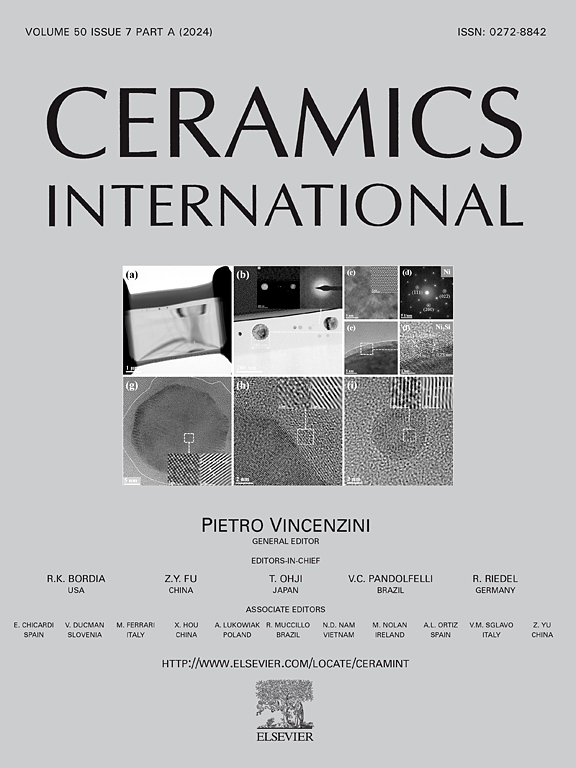New functionalities of a bone cement by adding mechanochemically synthesized magnetic nanoparticles
IF 5.1
2区 材料科学
Q1 MATERIALS SCIENCE, CERAMICS
引用次数: 0
Abstract
New formulations of calcium phosphate cements (CPCs) with magnetic properties have been developed. The CPC matrix was prepared from an equimolar mixture of tetracalcium phosphate (TTCP) and anhydrous calcium hydrogen phosphate (DCPA), using Na2HPO4 solution as liquid phase. Naked and functionalized iron oxides nanoparticles (IONPs), were incorporated into the CPC solid phase and the effect of the different contents of IONPs on the initial and final setting times of the CPCs was investigated. Moreover, magnetic properties, antibacterial activity and magnetic hyperthermia response of these systems were evaluated. The results showed a clear influence of the IONPs in the setting process, with low conversion of hydroxyapatite (HA), especially for contents greater than 10 wt%. Magnetization values of 5.6 and 11.4 emu/g at the maximum applied field (13 kOe) for CPC with 10 and 20 wt% of IONPs respectively, were obtained. Magnetic hyperthermia of CPC with 10 wt% of IONPs showed a specific power absorption (SPA) of 0.22 (W/g). Similar values of SPA were obtained for cements with functionalized IONPs. Also, CPC with 10 wt% of functionalized IONPs with usnic acid showed antibacterial activity against L. inoccua. These data are promising, considering that the concentration of IONPs in the cement is only equivalent to 10 wt% of the material.
我们开发出了具有磁性的磷酸钙水泥(CPC)新配方。CPC 基体由磷酸四钙(TTCP)和无水磷酸氢钙(DCPA)的等摩尔混合物制备而成,以 Na2HPO4 溶液为液相。在 CPC 固相中加入了裸铁氧化物和功能化铁氧化物纳米颗粒(IONPs),并研究了不同含量的 IONPs 对 CPC 初始和最终凝固时间的影响。此外,还评估了这些系统的磁性能、抗菌活性和磁热反应。结果表明,IONPs 对凝固过程有明显的影响,羟基磷灰石(HA)的转化率较低,尤其是含量大于 10 wt%时。含有 10 和 20 wt% IONPs 的 CPC 在最大应用磁场(13 kOe)下的磁化值分别为 5.6 和 11.4 emu/g。含有 10 wt% IONPs 的 CPC 的磁热效应显示出 0.22 (W/g) 的比吸收功率 (SPA)。含有功能化 IONPs 的水门汀也获得了类似的 SPA 值。此外,含有 10 wt% 的功能化 IONPs 和 usnic 酸的 CPC 对 L. inoccua 具有抗菌活性。考虑到水泥中 IONPs 的浓度仅相当于材料的 10 wt%,这些数据是很有希望的。
本文章由计算机程序翻译,如有差异,请以英文原文为准。
求助全文
约1分钟内获得全文
求助全文
来源期刊

Ceramics International
工程技术-材料科学:硅酸盐
CiteScore
9.40
自引率
15.40%
发文量
4558
审稿时长
25 days
期刊介绍:
Ceramics International covers the science of advanced ceramic materials. The journal encourages contributions that demonstrate how an understanding of the basic chemical and physical phenomena may direct materials design and stimulate ideas for new or improved processing techniques, in order to obtain materials with desired structural features and properties.
Ceramics International covers oxide and non-oxide ceramics, functional glasses, glass ceramics, amorphous inorganic non-metallic materials (and their combinations with metal and organic materials), in the form of particulates, dense or porous bodies, thin/thick films and laminated, graded and composite structures. Process related topics such as ceramic-ceramic joints or joining ceramics with dissimilar materials, as well as surface finishing and conditioning are also covered. Besides traditional processing techniques, manufacturing routes of interest include innovative procedures benefiting from externally applied stresses, electromagnetic fields and energetic beams, as well as top-down and self-assembly nanotechnology approaches. In addition, the journal welcomes submissions on bio-inspired and bio-enabled materials designs, experimentally validated multi scale modelling and simulation for materials design, and the use of the most advanced chemical and physical characterization techniques of structure, properties and behaviour.
Technologically relevant low-dimensional systems are a particular focus of Ceramics International. These include 0, 1 and 2-D nanomaterials (also covering CNTs, graphene and related materials, and diamond-like carbons), their nanocomposites, as well as nano-hybrids and hierarchical multifunctional nanostructures that might integrate molecular, biological and electronic components.
 求助内容:
求助内容: 应助结果提醒方式:
应助结果提醒方式:


